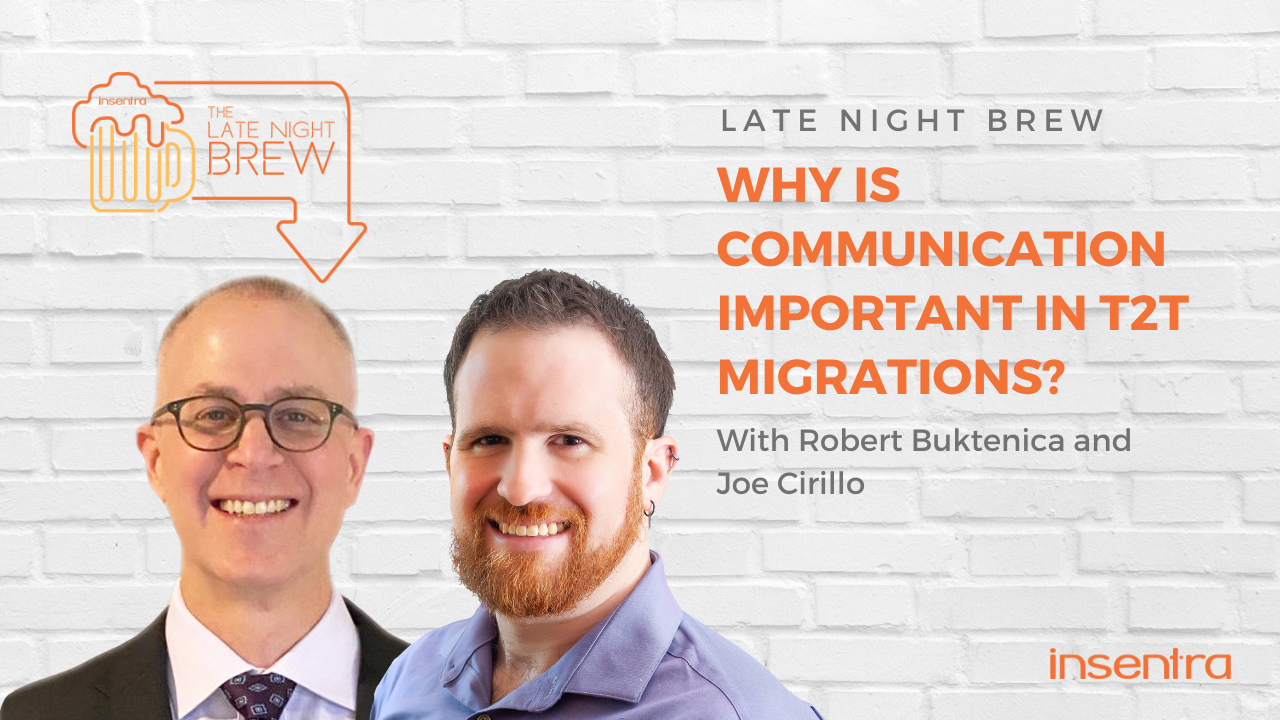Tenant-to-tenant migrations entail a massive change for end-users. Naturally, users will feel confused or lost during the process. This is why it’s important to include a solid communications strategy in your migration project.
In this episode of Late Night Brew, Robert Bucktenica and Joe Cirillo explore how communication impacts the success of your T2T migration. Watch the episode now to join the conversation.
TIMESTAMP
00:07 – Introduction
00:40 – The Brew
02:25 – Why is communication important during a T2T migration?
05:36 – What can go wrong or miss the mark in communications?
TRANSCRIPT
Introduction
Robert Buktenica: Hello, everyone, and welcome to another episode of the the Late Night Brew, where we talk the brews first and then we get around to what we’re supposed to eventually. Joining me, once again, for this episode series on tenant-to-tenant migrations is Joe, welcome back, buddy.
Joe Cirillo: Good afternoon, good evening to everyone.
Robert: Now, before we get into the deep dive of communication and why it is so important, we touched on a little bit in the last episode and I felt it’s really important to give it what it’s worth, Joe, what are you enjoying with me today?
The Brew
Joe: Today, believe it or not, I’m drinking a—I know it sounds weird—diet A&W, but it is the one actual diet soda that my wife and I found that actually tastes as close to the real thing as you can possibly get. So it’s the one that I can—I’m not a big diet soda fan, I’m a usually big soda fan in general but it’s good, it’s real good.
Robert: Two anecdotes on root beer, the main one though is for Europeans, root beer is typically the flavor of their medicine, so they think we’re absolutely insane for drinking root beer intentionally.
Joe: How interesting.
Robert: They’re like, “Why would you drink medicine?” Americans are crazy for a lot of reasons. With me, actually, I have a local Arizona brewery, Barrio Hipster Hazy IPA. I don’t know if it comes across but it’s got a little hipster mustache and beer in part of the label. It’s quite a good one. It’s wheat beer, more wheat. It tastes more like wheat than it does an IPA. It’s a good one in my opinion.
Joe: It’s good. If I was going to drink a beer, it’d be a wheat beer.
Robert: I’m a huge fan of citrus season, at least at the time of recording, it’s coming, and I love the Hefeweizens with juice, it’s so good, so good. Anyway, we could spend the whole episode talking about that. Unfortunately, that’s not why they’re tuning in.
Why is communication important during a T2T migration?
Robert: Why is communication so important during a tenant-to-tenant migration?
Joe: Great question, yes. Now, it is absolutely critical that the end user does not experience any surprises, right? I mean, we know it’s a migration. We know that we have to do things like touch the endpoint, so there is going to be some impact to the end user, and so the whole goal of the communications plan is to stay in front of that from a risk perspective. Making sure that you’re communicating often with the end users.
Most organizations will develop what they call a t-minus plan. T-minus thirty, t-minus fifteen days, t-minus seven days and so forth, so it’s good. I know in the last episode we talked a little bit about ways to communicate through FAQs, internal websites and internet, and so on and so forth, making sure the end users have a way to contact support and have a place to go.
Robert: And the resources available.
Joe: And the resources and all of that. To supplement that from a communications plan perspective is definitely sort of that t-minus plan as well. Give them way out, “Hey, this is coming.” Get them fully prepped and ready to go. Because oddly enough, although you might be sending those communications, and typically through email, we all know that usually the clickthrough rate on email messages like that are extremely low.
You do want to keep messages like that pretty clean and precise. You don’t want to put too much information in them, keep them fairly short but make sure they have impact.
Robert: I don’t know what you’re talking about, I read every email that comes into my inbox.
Joe: Of course, especially when there’s an update to the backend systems too, right?
Robert: Yes, exactly.
Joe: You want to know exactly what’s happening.
Robert: I remember one of my mentors back when I started my career, their advice—and this is just general, any email—after the first paragraph, first few sentences, you’ve lost them. Ninety percent of people read that first chunk, call it two, three lines. If you don’t get across what you need in those, ninety percent of people are going to completely miss it, because they’re not reading. There’s going to be ten percent, right?
However, that’s not the people you’re worried about especially during this kind of process.
Joe: Yes, absolutely, especially if you’re trying to get way too fancy and provide a bunch of instructions in that email, then you completely lose them. Really, the instructions are for a different medium outside of the email. The email should really just be used to just notify and make sure they’re fully up to date on what’s going to occur, when and those type of things.
Robert: Now, that’s a great lead in of—I mean, both you and I have worked them together and I know we’ve got quite a few under our belt. I know we can both contribute in this question at least, what can go wrong, what can miss the mark—I’ve already alluded to, if it’s too long, no one’s reading it—in communicating or communications?
What can go wrong or miss the mark in communications?
Joe: What could go wrong? Again, honestly, again, try and encourage people to read the emails. I’ve seen where organizations will even have lunch-and-learns or outside, just get them outside the email message method of communications.
In this remote world, I know it’s a little bit more challenging, but maybe host some like online event or something like that to help communicate as well.
A good tactic that I had one customer use, which was I thought from a marketing perspective was fabulous, was everything was geared towards the end user, like, “You asked for this, you want it.” You kind of put it and they’re like, “Oh great, I want it,” and so get them a little bit more engaged.
You really do have to find creative ways to get the end users engaged and aware outside of just, again, sending just an email.
Robert: Definitely, in my experience, especially with some of the larger organizations I’ve helped migrate, having champions in departments is huge. “Hey, you are responsible for helping talk, helping answering questions,” and having that person among them that’s not just IT, it’s not just this email, it’s your team lead saying, “Hey, this is happening, what questions do you have?”
Being that liaison and the cheerleader, champion, however you want to call it. I have seen really, really good results because, hey, we have someone we can talk to and tap on the shoulder, and that’s valuable.
Joe: Yes, I absolutely agree. Somebody they can go to that has maybe even been they were a part of the pilot, so they have some real hands-on experience with what’s going to occur as part of the migration, answer questions, absolutely. Yes, totally agree.
Robert: On those good examples, we have unfortunately—Joe, you and I, we get to talking too much and we ate up our time. Please, feel free to reach out if you have questions. All the links are below, especially to the previous episodes and the next one. Until next time, Joe, thank you very much for joining me, Sir. Take care.
Joe: Thank you.
And there we go! Now that you know the secret to a succesful T2T migration, it’s time to start drawing up your communications plan to supplement your migration project.
Check out our A Comprehensive Guide to Microsoft 365 Tenant Migrations ebook as well for a more comprehensive guide on T2T migration projects.
Don’t know where to start with tenant migrations? Feel free to check out our MapTo advisory services or contact us today.











